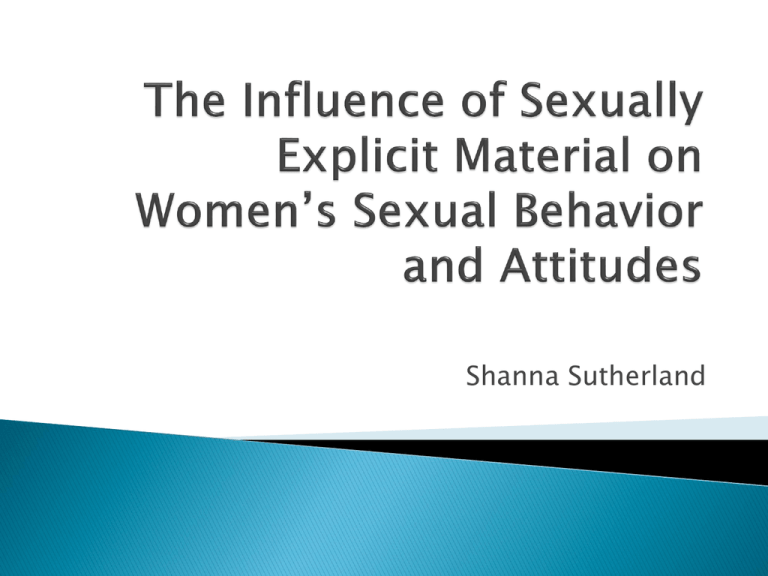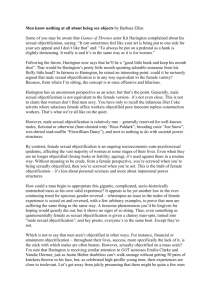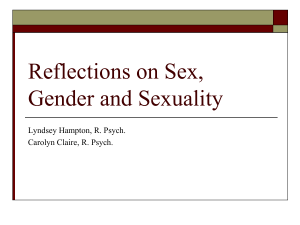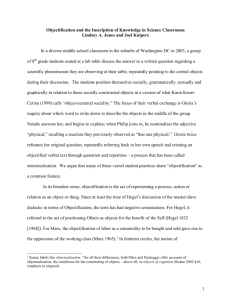
Shanna Sutherland
The USA is the world’s leading producer (73%)
of online pornography (MacKay, 2001).
Sexual representation, products and services
are becoming more accessible to a wider
group of consumers (Attwood, 2006).
Pro-sex
Anti-pornography
◦ Women take control of
their sexuality when
they engage with SEM.
◦ Pornography reduces
women to sexual objects
to be consumed by men
(MacKinnon, 1987).
◦ Enjoying pornography is
a form of resistance to a
culture that allows no
sexual pleasure for
women at all (Philipson,
1984).
◦ Men can be degraded
through instrumental
sexual use by women as
well (Kant,1993).
Sexual desire produced by pornography frequently leads
to the objectification of others (Shrage, 2005).
One consequence for women of being viewed as sexual
objects is that women start to treat themselves as objects
(Noll & Fredrickson, 1998).
Noll and Fredrickson (1998) define self-objectification as
valuing one’s body from a third person perspective where
one focuses on observable body attributes (e.g., How do I
look?) rather than from a first person perspective where
one focuses on non-observable body attributes (e.g., What
am I capable of? How do I feel?).
Individuals who consume high levels of
pornography tend to be more sexually active and
report a higher frequency of masturbation (Hald &
Malamuth, 2008).
Will exposure to sexually explicit material be
correlated with women’s sexual attitudes and
behaviors?
Exposure to sexually explicit materials will
be correlated with greater selfobjectification and greater objectification of
sexual partners.
Exposure to sexually explicit materials will
be correlated with greater engagement in a
variety of sexual behaviors.
◦ 23 people excluded, leaving 169 total participants
◦ Females ranging in age from 18 to 57 with a mean of
23.24
◦ 82.8% Caucasian, 7.7% African American, 3% Hispanic,
1.2% Asian, 5.3% Other
◦ 46.6% Single, 36.9% In a Relationship, 15.3% Married,
1.2% Divorced
◦ 6.5% High School or Less, 64% Some College, 8.9%
Associate’s, 11.2% Bachelor’s, 9.4% Higher Education
◦ An online survey that measured
Demographics
Types and Frequency of SEM
Self-Objectification
Sexual Partner-Objectification
Sexual Behaviors
Please indicate the frequency with which you
have read Cosmopolitan in the previous year
Not at all
1 to 3 times
4 to 6 times
6 to 12 times
2 to 3 times a month
About once a week
Twice or more times a week
(Lawrence & Herold, 1988)
Interpersonal Sexual Objectification Scale (Noll &
Fredrickson, 1998)
◦ 5 Appearance-based items: Weight is important to my
concept of self
◦ 5 Competence items: Health is important to my concept of
self?
◦ Participants rate each item on a 5 point Likert scale
◦ Scale was scored by subtracting the mean of the
competence-based items from the mean of the appearancebased items; higher scores indicate more self-objectification
Revised Interpersonal Sexual Objectification Scale
(Noll & Fredrickson, 1998)
◦ 5 Appearance-based items: Weight is an attribute that I
look for in a sexual partner
◦ 5 Competence items: Health is an attribute that I look for in
a sexual partner
Rouse-Pattison Sexual Behavior Scale (2004)
◦ Please indicate how many times in the previous year you
have had vaginal intercourse.
Not at all
1 to 3 times
4 to 6 times
6 to 12 times
2 to 3 times a month
About once a week
Twice or more times a week
Once or more a day
The mean of the participants looking at
sexually explicit material in the previous year
was, m = 1.52, this mean correlates with the
answers 1 to 3 times a year and 3 to 6 times
a year.
Therefore, it can be concluded that
participants in this study view or read a
variety of sexually explicit material between 1
and 6 times a year.
Self Objectification scale was reliable
◦ appearance items, alpha = .82
◦ competence items, alpha = .79
There was a marginally positive correlation
between SEM use and self objectification,
r = .14, p = .08. This correlation indicates
that the more SEM the women view/read the
more likely they are to self-objectify.
Partner Objectification scale was reliable
◦ appearance items, alpha = .80
◦ competence items, alpha = .83
There was a marginally positive correlation
between SEM use and objectification of sexual
partners, r = .14, p = .08 This correlation
indicates that the more SEM the women
view/read the more likely they are to objectify
their sexual partners.
The Sexual Behavior scale was reliable
◦ alpha = .93
There was a significant positive correlation
between SEM use and sexual behaviors,
r = .31, p < .001. This correlation indicates
that the more SEM the women view/read the
more likely they are to engage in sexual
behaviors of various kinds.
The results suggest that SEM use is associated
with greater sexual activity. Also, the results
show a trend indicating that the more frequently
women use SEM the more likely they are to selfobjectify and view their partners in objectified
ways.
The objectification results help support the AntiPornography feminist theory and suggest that
pornography can be associated with negative
sexual attitudes for both men and women.
Examine the consequences of selfobjectification and making the other an
object.
Examine the consequences of SEM use on
other sexual attitudes (e.g., relationship
satisfaction).











